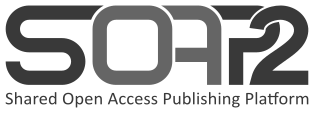Archives
-
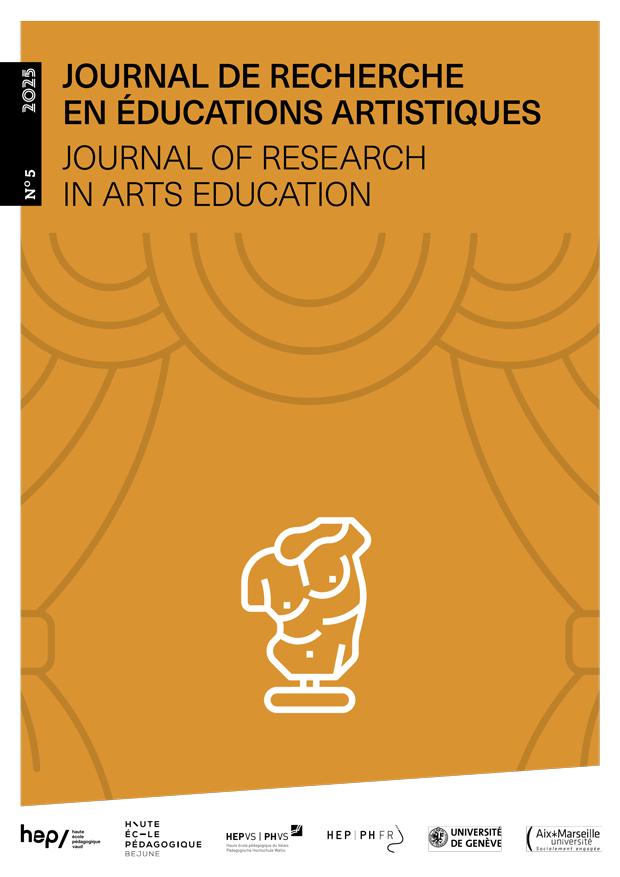
Plastic/visual arts and drama/performing arts in teaching and research: What approaches and what prospects for fomorrow's school ?
No. 5 (2025)This 5e issue of the Journal of Research in Arts Education / Journal de recherche en éducations artistiques is part of an interdisciplinary and transdisciplinary dynamic that needs to be documented, invented or reinvented. The aim here is to explore the place of sensibility in education as a foundation for cross-disciplinary skills linked to the teaching and learning process. This link is constitutive of the 'between' (Jullien, 2011) from which can emerge a 'relational aesthetic' (Bourriaud, 1998) between the teacher and the pupil, the participants and the researcher, the creator and the environment, the different arts, the arts and other disciplines, between the intelligible and the sensible, etc. At the crossroads of the visual arts and theatre, the fine arts and the performing arts, the complex relationship between self, other(s) and environment(s) shapes methodological approaches in teaching and research, just as it plays a part in cognitive processes. What sensitive educational models are being proposed around the world ? In what way do these new performative models invite us to reconsider the place given to scholarly knowledge, expert knowledge, academic models, social reference practices or socially topical issues in the various education systems ?
-
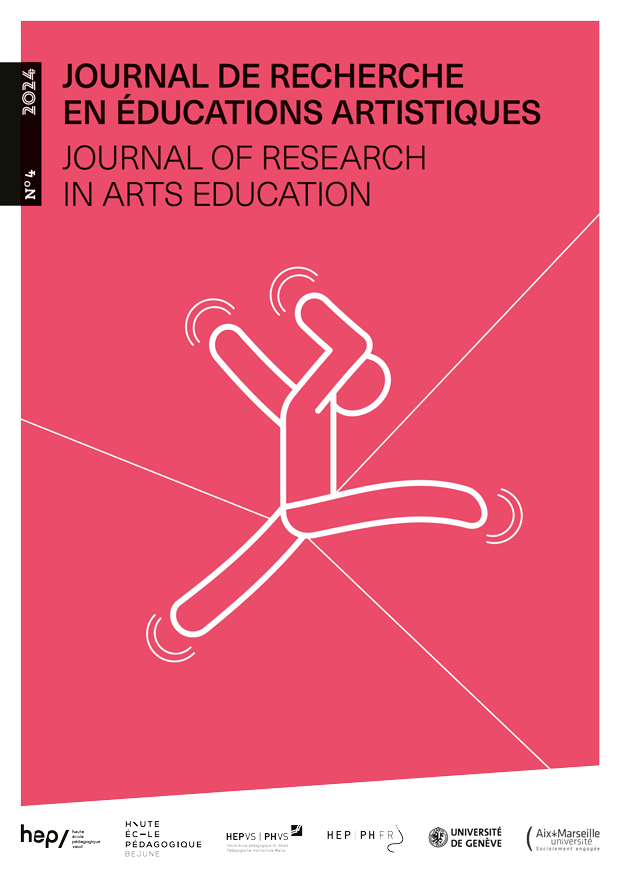
The place of the body in education of art creation: Challenges and questions
No. 4 (2024)This issue 4 of the JREA/JRAE journal follows a study day organized at the HEP_Vaud University of Teacher Education on June 6th, 2023. It explored the challenges raised by the body in education of art creation. In this issue, we would like to publish articles related to this subject.
While the verb “to transmit” is embodied in dance education, as it literally refers to “put into someone else’s body” (Mili & al., 2013, p.92), the proposal consists of interrogating the concept of transmission by expanding it to other art disciplines in their diversity (visual arts, music, design, creative activities, performing arts, etc.).
During the 20th century, art disciplines in education moved from an approach centered on the final product and technical skills to one based on process (Lahalle & Lagoutte, 2006) as an art “making” at the border of practice and thinking (Pélissier, 1998). From this perspective, the special issue attempts to define the close relationship between the embodied knowledge process and creation process in art education. It questions the notions of corporeality, corps propre, incorporation, and embodiment during the creation process in an educational environment.
Although the body became central in education from the beginning of the 20th century with the emergence of active teaching methods (Jaques-Dalcroze, Montessori, Kodály, Willems, Orff, Freinet, etc), Pujade-Renaud (2005) describes a completely different reality in the training context. This is crystallized into the invisibilization of a “zombie-student’s” body (p.13), the presence of which is reduced to the simple use of the ear and hand. The author suggests “the restoration of our relational, corporeal, and affective life, facilitated by spatial change, to foster language circulation” (p.51).
The contribution of the cognitivist approach, on which education sciences have been based for a long time, seems to have reached its limits in several research areas such as psychology, neuroscience, philosophy, and linguistics. New approaches, such as embodied cognition, follow phenomenological perspectives and open educational pathways by replacing the body at the center of the learning process.
In the more specific field of artistic education, we ask about the extent to which learners’ corporeality is involved in creating experiences in art disciplines. We propose to explore this theme around three axes: the mediator body (the body in direct relationship with its surrounding environment), mediated body (the body with regard to digital and non-digital technologies), and mediatized body (challenges of distance art education).
-
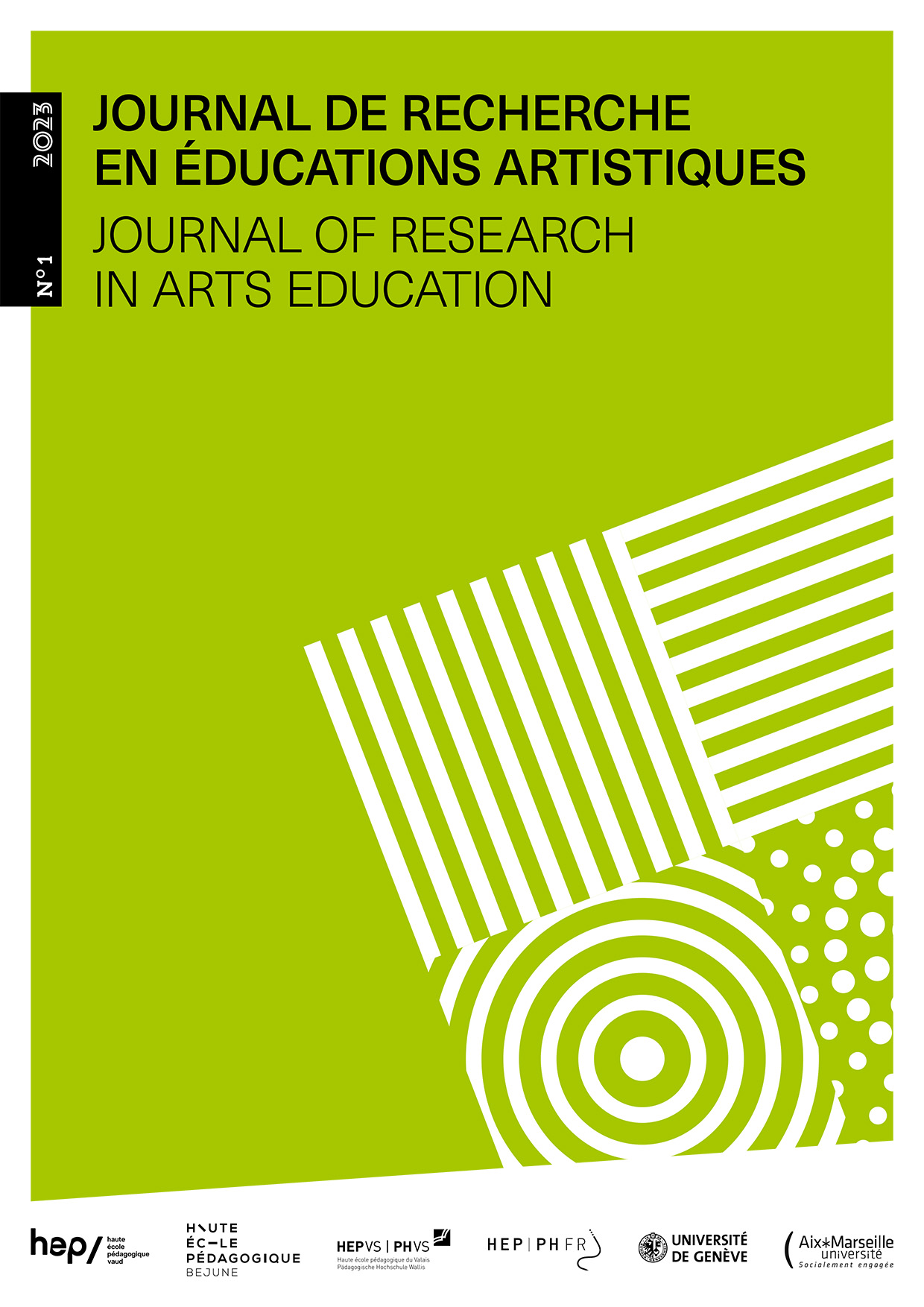
The notion of didactics in arts education
No. 1 (2023)The theme of this first issue of Journal of Research in Arts Education - Journal de recherche en éducations artistiques focuses on the notion of didactics in arts education. This notion has different meanings and applications depending on the country, the discipline and the teaching-learning situation. For some, the notion of didactics is an implementation of teaching know-how. For others, it is a form of training design, or an object of research on teaching-learning processes. What are the discourses, discussions and controversies that coexist at an international level in the different artistic disciplines? On what epistemological and methodological bases are these differences or similarities founded? What paradigms run through this notion of didactics?
In the field of didactic research, we wish to confront points of view around people’s development through teaching or learning in arts education. We invite researchers, professors/associate professors, teacher-trainers and artist-teachers to explain the foundations and characteristics of the notion of didactics in their discipline.
In this first JRAE/JREA issue seven articles are published: five in French and two in English. Each of these seven articles has been co-authored by at least two researchers, most of them coming from different university art education institutions from the same or from different countries (Canada, France, Germany, Ireland, Switzerland) in order to cross-reference concepts of didactics in music, visual arts, applied arts/design, dance and theatre teaching at an international level.
-
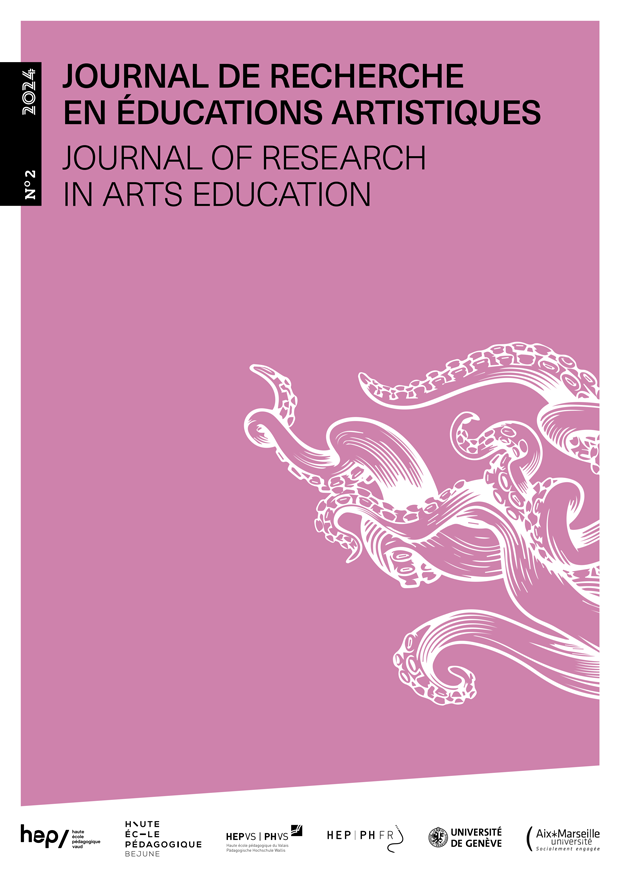
The moving body in music and dance education
No. 2 (2024)For this second issue JREA/JRAE, we wish to publish articles on the teaching of music and dance. The aim is to focus on work in music and dance didactics and pedagogy, with a particular emphasis on the role of movement and gesture. Music learning and movement are intrinsically linked, particularly in the teaching of Dalcroze eurhythmics (Brice, 2014; Croset, & Willen, 2015) and in collective or individual instrumental practices (Batézat-Batellier, 2017; Guillot, 2011; Tortochot, & Terrien, 2021). This research can question the role of musical gestures in the transmission and construction of knowledge, as well as the place of body movements in instrumental learning (Rickenmann et al., 2019; Terrien, 2013, 2022), in school music teaching (Bremmer, 2015, 2021; Moor et al., 2020; Nijs, & Bremmer, 2019; Terrien, & Leroy, 2012) and in special needs teaching (Bremmer et al., 2021).
In dance teaching at school, knowledge learning comes about through the body in movement
(Duval et al., 2022) and recent studies have focused on teachers' didactic and pedagogical practices that foster the achievement and development of each student in a more inclusive environment (Duval, & Arnaud-Bestieu, 2021). In higher education, recent research on dance teacher education raises awareness of pedagogical and choreographic understanding and innovation among future professionals (Arnaud-Bestieu, 2019; Simonet, 2019).
This second issue also aims to collect results from educational research that cross-reference these two artistic disciplines, where emblematic tasks such as improvisation, composition and work on forms can be studied (Arnaud-Bestieu, & Terrien, 2018; Espinassy, & Terrien, 2018). How does the teacher guide these teaching/learning situations? How do students' responses reconfigure the lesson? How can teachers create pedagogical environments that are both open and retroactive to enable learning?
-
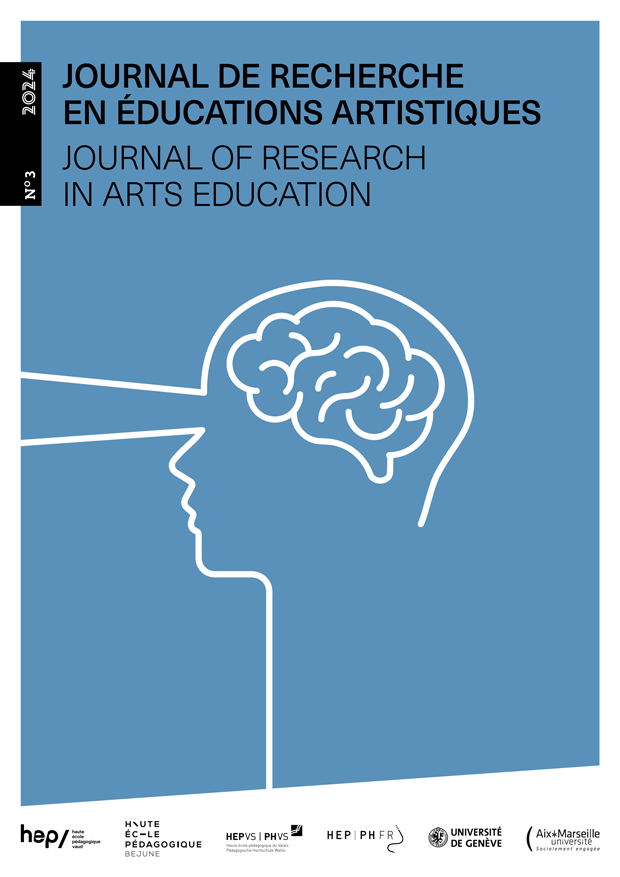
Design and its teaching : State of play and perspectives
No. 3 (2024)While research on design education has been abundant in Anglo-Saxon scientific literature for the past 50 years, the recent emergence of a community of Francophone and German-speaking researchers is now worthy of note. Following in the footsteps of Special Issue No. 15 of the journal Sciences du design (Dupont & al., 2022), this third issue of the international peer-reviewed journal Journal de recherche en éducations artistiques/Journal of research in arts education (JREA/JRAE) is a strong indication of this.
The aim of the call for publication of Issue 3 JREA/JRAE is to get members of this community to reflect on a discipline of the "in-between" (Petit, 2023) along three lines.
The first focuses on research in educational sciences and the history of arts education : what do we know about the teaching of design as it was constituted in its more or less recent history and as it is characterised today ? In short, it is a question of contributing to an epistemological, historical, didactic reflection on design and its teaching together, in order to understand what is being designed today and what was taught yesterday, and what is being taught today to enable design tomorrow (Tortochot, 2023).
The aim of the second, is to show the importance of research for the teaching of design in order to better understand the challenges of the school of the future (Didier, 2021). Again, there is an underlying epistemological approach : what are we talking about when it comes to the teaching of design? What design are we talking about when it comes to teaching design through projects ? Why do we need to clarify these points if it is not because we have to respond to strong societal pressure in the face of technological complexities and demands for collective progress, for a technical democracy ?
The third, offers an opportunity to open up to the place of the artefact as a mediator interacting with the autonomous learner (Küttel, 2022) to contemplate the teaching of design. What is at stake is the aesthetic experience of the world and the complex systems of which it is formed. The individual is an actor-network (Latour, 1998) : he/she creates realities in this world, he/she establishes structures as well as links in an evolving situation.
The authors take up these questions, which they enrich with their points of view to work on collective research.

